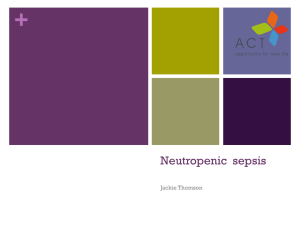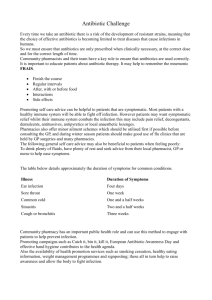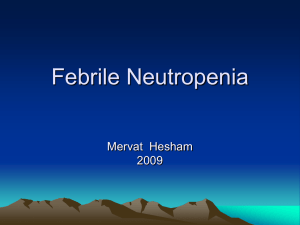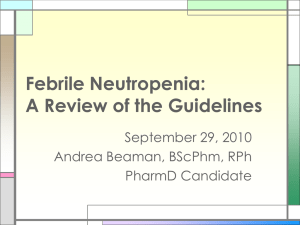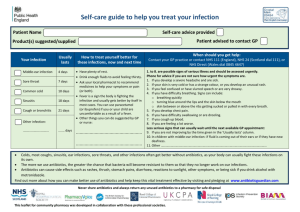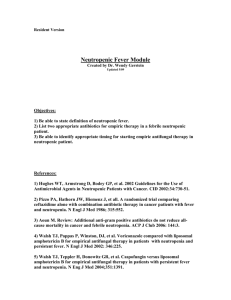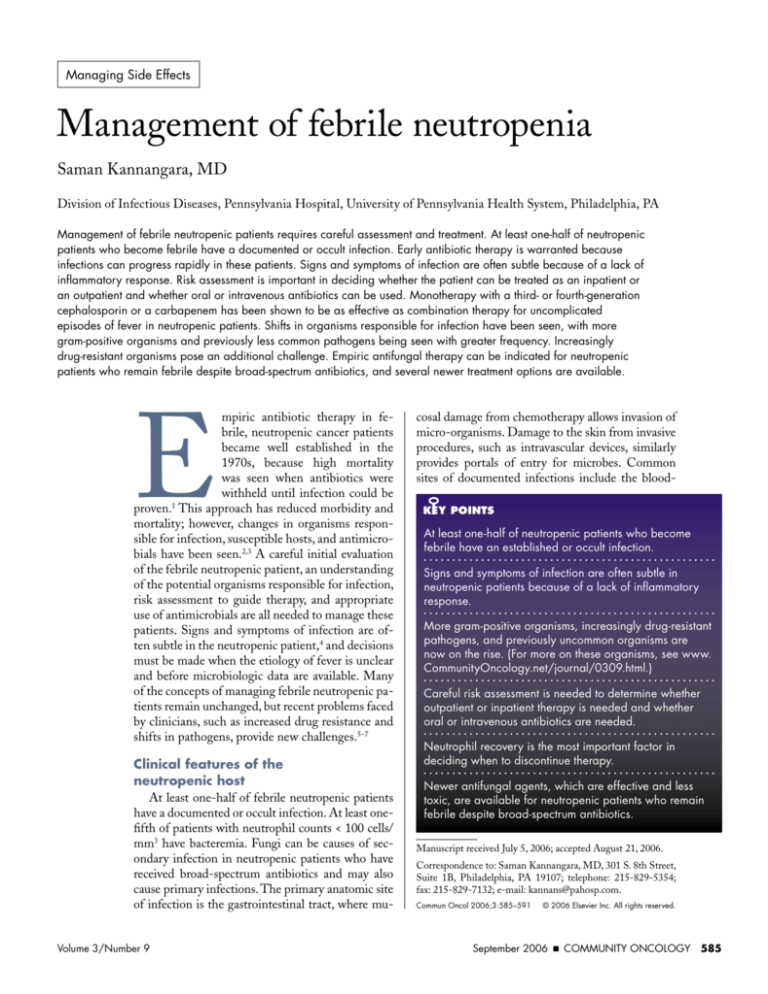
Managing Side Effects
Management of febrile neutropenia
Saman Kannangara, MD
Division of Infectious Diseases, Pennsylvania Hospital, University of Pennsylvania Health System, Philadelphia, PA
Management of febrile neutropenic patients requires careful assessment and treatment. At least one-half of neutropenic
patients who become febrile have a documented or occult infection. Early antibiotic therapy is warranted because
infections can progress rapidly in these patients. Signs and symptoms of infection are often subtle because of a lack of
inflammatory response. Risk assessment is important in deciding whether the patient can be treated as an inpatient or
an outpatient and whether oral or intravenous antibiotics can be used. Monotherapy with a third- or fourth-generation
cephalosporin or a carbapenem has been shown to be as effective as combination therapy for uncomplicated
episodes of fever in neutropenic patients. Shifts in organisms responsible for infection have been seen, with more
gram-positive organisms and previously less common pathogens being seen with greater frequency. Increasingly
drug-resistant organisms pose an additional challenge. Empiric antifungal therapy can be indicated for neutropenic
patients who remain febrile despite broad-spectrum antibiotics, and several newer treatment options are available.
E
mpiric antibiotic therapy in febrile, neutropenic cancer patients
became well established in the
1970s, because high mortality
was seen when antibiotics were
withheld until infection could be
proven.1 This approach has reduced morbidity and
mortality; however, changes in organisms responsible for infection, susceptible hosts, and antimicrobials have been seen.2,3 A careful initial evaluation
of the febrile neutropenic patient, an understanding
of the potential organisms responsible for infection,
risk assessment to guide therapy, and appropriate
use of antimicrobials are all needed to manage these
patients. Signs and symptoms of infection are often subtle in the neutropenic patient,4 and decisions
must be made when the etiology of fever is unclear
and before microbiologic data are available. Many
of the concepts of managing febrile neutropenic patients remain unchanged, but recent problems faced
by clinicians, such as increased drug resistance and
shifts in pathogens, provide new challenges.5–7
Clinical features of the
neutropenic host
At least one-half of febrile neutropenic patients
have a documented or occult infection. At least onefifth of patients with neutrophil counts < 100 cells/
mm3 have bacteremia. Fungi can be causes of secondary infection in neutropenic patients who have
received broad-spectrum antibiotics and may also
cause primary infections. The primary anatomic site
of infection is the gastrointestinal tract, where muVolume 3/Number 9
cosal damage from chemotherapy allows invasion of
micro-organisms. Damage to the skin from invasive
procedures, such as intravascular devices, similarly
provides portals of entry for microbes. Common
sites of documented infections include the blood����������
At least one-half of neutropenic patients who become
febrile have an established or occult infection.
Signs and symptoms of infection are often subtle in
neutropenic patients because of a lack of inflammatory
response.
More gram-positive organisms, increasingly drug-resistant
pathogens, and previously uncommon organisms are
now on the rise. (For more on these organisms, see www.
CommunityOncology.net/journal/0309.html.)
Careful risk assessment is needed to determine whether
outpatient or inpatient therapy is needed and whether
oral or intravenous antibiotics are needed.
Neutrophil recovery is the most important factor in
deciding when to discontinue therapy.
Newer antifungal agents, which are effective and less
toxic, are available for neutropenic patients who remain
febrile despite broad-spectrum antibiotics.
Manuscript received July 5, 2006; accepted August 21, 2006.
Correspondence to: Saman Kannangara, MD, 301 S. 8th Street,
Suite 1B, Philadelphia, PA 19107; telephone: 215-829-5354;
fax: 215-829-7132; e-mail: kannans@pahosp.com.
Commun Oncol 2006;3:585–591
© 2006 Elsevier Inc. All rights reserved.
September 2006
■
COMMUNITY ONCOLOGY 585
MANAGING SIDE EFFECTS
Kannangara
Bacterial pathogens commonly
implicated in neutropenic fever
Gram-positive organisms
Staphylococcal species
Coagulase-negative staphylococci
Staphylococcus aureus
Streptococcal species
Viridans group
Streptococcus pneumoniae
Streptococcus pyogenes
Enterococcal species
Corynebacterium species
Gram-negative organisms
Escherichia coli
Klebsiella species
Pseudomonas aeruginosa
Enterobacter species
Acinetobacter species
Stenotrophomonas maltophilia
Non-aeruginosa Pseudomonas species
*More on these organisms can be found at
www.CommunityOncology.net/journal/0309.
stream (15%–20%), the gastrointestinal tract (enterocolitis and perirectal
infection), integument (skin and soft
tissue, vascular access sites, catheter
insertion sites), and the respiratory
tract (sinusitis and pneumonia).
Fever
A fever can be defined as a single
oral temperature ≥ 38.3°C or 101°F
or a temperature of ≥ 38°C or 100.4°F
for at least 1 hour.8
Neutropenia
Neutropenia can be defined as an
absolute neutrophil count (ANC) <
500 cells/mm3 or an ANC < 1,000
cells/mm3 with a predicted decline to
< 500 cells/mm3. The infection rate
and severity are inversely related to the
ANC.9–11 Lower ANCs are associated
with more frequent and severe infections, and conversely, higher ANCs
correlate with less frequent and severe
infections. Patients with neutrophil
counts < 500 cells/mm3 are at significantly increased risk for infection compared with those with counts < 1,000
cells/mm3; similarly, patients with
counts < 100 cells/mm3 are at even
greater risk for infection than are those
586 COMMUNITY ONCOLOGY
■
September 2006
with counts < 500 cells/mm3. The duration of neutropenia is also an important determinant of risk of infection.
Patients with a low ANC and prolonged neutropenia (eg, > 10 days) are
at further increased risk of infection.9,12
Initial evaluation
A thorough history is extremely
important when evaluating patients
for febrile neutropenia. The history should include the nature of the
chemotherapy given, prior antibiotic prophylaxis, concomitant steroids
or other immunosuppressives, recent
documented colonization or infection
with susceptibilities, recent surgical
procedures, and medication allergies.
In neutropenic patients, symptoms and signs of inflammation may
be minimal or absent.4 The lack of
inflammatory response can make detection of infection more difficult and
requires close physical examination
for more subtle signs and symptoms.
There will likely be decreased erythema, induration, and purulence in
response to bacterial infections (eg, a
skin infection without typical features
of cellulitis, a pulmonary infection
without a clear infiltrate, meningitis
that lacks cerebrospinal fluid pleocytosis, and urinary tract infections
without pyuria). Careful evaluation of
common sites of infections should include the mouth, pharynx, esophagus,
lungs, perineum, eyes, skin, and vascular catheter access sites.
Laboratory studies include measurement of complete blood counts,
serum creatinine levels, blood urea nitrogen, transaminase levels, and blood
cultures. Blood cultures should be obtained from a peripheral vein and
catheter if present.13 Depending on
the clinical situation, other cultures
can be obtained. Skin biopsies can
also be obtained if indicated. If respiratory signs or symptoms are present,
a chest x-ray can be performed.
Risk assessment
Risk assessment is important in
deciding whether febrile neutopenic
patients can be treated as inpatients
or outpatients and whether oral or
intravenous antibiotics can be used.
Historically, characteristics of low
risk for serious medical complications
include outpatient conventional chemotherapy for solid tumors, normal
chest x-ray, hemodynamic stability,
expected duration of neutropenia ≤
7 days, normal kidney and liver function tests, early evidence of marrow
recovery, malignancy in remission,
and normal mental status.
Two classification systems are
notable: the Talcott classification14 of risk
groups and a scoring system proposed
by the Multinational Association
for Supportive Care in Cancer
(MASCC)15 group. Both systems
use serious medical complications
as the endpoint for risk prediction.
However, the sensitivity of the Talcott
classification is limited (approximately
30%), and the misclassification rate
is high. For example, many patients
who do not have complications are not
identified by the prediction rule. Also,
when the classification system was
used on patients discharged for home
intravenous antibiotics after 2 days of
inpatient observation, the complication
rate was higher than anticipated.16
The MASCC group scoring system is
based on patient history, age, outpatient
status, clinical status at presentation,
and comorbidities.15 Low-risk patients
are identified as those with a score
> 20. This scoring system is suitable
for clinicians because of its simplicity
and greater sensitivity than the Talcott
system. However, the MASCC system
has not been studied extensively in
outpatients.
Adults at low risk for complications
with neutropenic fever may be treated
with oral antibiotics.17,18 The use of oral
antibiotics can be considered for lowrisk patients who present only with fever; such patients should have no focus of bacterial infection or symptoms
or signs of systemic infection, such as
chills or hypotension. Some low-risk
www.CommunityOncology.net
Management of febrile neutropenia
patients can be treated as outpatients;
however, many studies that have supported use of oral antibiotics involved
hospitalized patients.18 Close observation and easy access to medical care are
essential for patients with febrile neutropenia treated as outpatients. Another outpatient therapy strategy consists
of brief inpatient admission with use of
intravenous antibiotics, obtaining cultures and results, and excluding serious
infection prior to discharge with oral
antibiotics.
Initial antibiotic therapy
Early antibiotic therapy is warranted in febrile neutropenic patients because infections can progress rapidly.
Bacterial infections may not be easy to
distinguish from noninfections in neutropenic patients with fever. Empiric
antibiotics should also be considered for
afebrile neutropenic patients who have
signs and symptoms of infection (Table
2). Considerations influencing antimicrobial selection include center-specific
factors (namely local patterns of antibiotic resistance) and patient-specific factors (recent antibiotics, quinolone prophylaxis, drug allergies, and signs and
symptoms).
Need for empiric vancomycin
Indications for empiric use of vancomycin for febrile neutropenia include clinically suspected catheterrelated infection, known colonization
with penicillin- or cephalosporin-resistant organisms or colonization with
methicillin-resistant S. aureus, blood
cultures positive for gram-positive
organisms (before identification and
susceptibility testing), or hypotension.19 In some centers, intense chemotherapy with mucosal damage and
quinolone prophylaxis are also indications for empiric vancomycin. For patients with an indication for empiric
vancomycin, or colonized with vancomycin-resistant organisms, linezolid
may be an alternative. A recent randomized clinical trial demonstrated
similar efficacy and safety outcomes
Volume 3/Number 9
MANAGING SIDE EFFECTS
with linezolid and vancomycin in a
study of febrile neutropenic patients
with cancer.20 The potential for myelosuppression secondary to linezolid,
however, may be a concern.
Monotherapy or
combination therapy
Studies have shown no difference
in outcome between monotherapy and
combination therapy for empiric treatment of uncomplicated episodes of fever in neutropenic patients.21–24 All of
the drugs recommended for monotherapy have an adequate initial broad
spectrum in most settings. A third- or
fourth-generation cephalosporin (ceftazidime or cefepime [Maxipime]) or
a carbapenem (imipenem-cilastatin
[Primaxin] or meropenem [Merrem])
may be used as monotherapy. However, extended-spectrum beta-lactamases
and type-1 beta-lactamases have reduced the effectiveness of ceftazidime
for monotherapy.25 Also, in contrast to
ceftazidime, excellent activity against
viridans streptococci and pneumococci is demonstrated by imipenemcilastatin, meropenem, and cefepime.
Piperacillin-tazobactam (Zosyn) has
been studied less extensively as monotherapy for febrile neutropenia compared with other antimicrobials.23
The most common combination
regimens (not including vancomycin)
include piperacillin-tazobactam or ticarcillin-clavulanic acid (Timentin)
with an aminoglycoside (gentamicin,
tobramycin, or amikacin [Amikin]), an
antipseudomonal cephalosporin (cefepime or ceftazidime) with an aminoglycoside, and a carbapenem (imipenem-cilastatin or meropenem) with an
aminoglycoside. The possible advantages of combination therapy include
potential synergy against some gramnegative organisms,26 reduced risk of
emergence of drug-resistant bacteria,27
and a wider spectrum. Disadvantages
of combination therapy include higher
cost, increased toxicity, and the need
for laboratory monitoring of drug levels for aminoglycosides.
Duration of therapy
Antibiotic therapy for at least 3–5
days is generally required to determine
the efficacy of the empiric regimen.
Decisions regarding management of
the empiric treatment are based on
whether a documented infection is
present, the infection has resolved, or
the patient’s condition has worsened.
The most important factor in deciding when to stop antimicrobial therapy in febrile neutropenia is the ANC.
Afebrile by days 3–5 of
empiric treatment
If an infection is documented,
therapy can be adjusted to treat the
causative organism, but broad-spectrum antibiotics should be maintained
to prevent breakthrough bacteremia.
Antibiotic therapy should be given
for at least 7 days or until cultures
are sterile and the patient is clinically
improved. Achieving an ANC ≥ 500
cells/mm3 is favorable but may not be
necessary if neutropenia is prolonged
and clinical and microbiologic improvements are noted.
If the patient is at low risk and no
infectious etiology is identified, an
intravenous regimen can be switched
to an oral regimen of amoxicillin-clavulanate and ciprofloxacin (Cipro).18
The same intravenous antibiotics
should be continued for high-risk patients. Antibiotics can be stopped once
the patient is afebrile and the ANC is
≥ 500 cells/mm3 for 48 hours. If patients at initial low risk who are clinically stable become afebrile by days
3–5 of empiric therapy and the ANC
remains < 500 cells/mm3 by day 7,
antibiotics can be stopped when they
are afebrile for 5–7 days. Patients at
initial high risk, with an ANC < 100
cells/mm3, mucositis, or unstable vital signs, should remain on antibiotics
through the neutropenic period.
Persistent fever through
days 3–5 of treatment
Fever that persists > 3 days in neuSeptember 2006
■
COMMUNITY ONCOLOGY 587
MANAGING SIDE EFFECTS
Kannangara
tropenic patients on empiric antibiotic therapy with no site of infection
documented and culture results negative warrants reassessment. Possibilities include a nonpyogenic infection,
a drug-resistant organism, slow response to empiric antibiotics, emergence of a secondary infection, a subtherapeutic drug level, or a drug fever.
Some patients with documented infections may need ≥ 5 days of therapy
for fever to resolve.28,29
Reevaluation includes careful
physical examination, review of culture results, repeat cultures, examination of catheter sites, and additional
diagnostic imaging of suspected sites
of infection. Serum drug levels can
be checked if possible, and computed
tomography of the sinuses, chest, or
abdomen can be performed if indicated. If no source of fever is identified, the same antibiotic regimen can
be continued if the patient is stable
and clinically unchanged, antibiotics can be added or adjusted if progressive disease or drug toxicity is
apparent, or an antifungal agent can
be added to the antibiotic regimen if
resolution of neutropenia does not
appear to be imminent.8
If the patient remains febrile on
days 3–5 of broad-spectrum antibiotics and no infectious source of fever
is found, antibiotics can be stopped
TABLE 2
Empiric antibiotic therapy
Monotherapy
■
■
■
Antipseudomonal third-generation
cephalosporin (ceftazidime)
Fourth-generation cephalosporin
(cefepime)
Carbapenem (imipenem-cilastatin or
meropenem)
Combination therapy
■
■
■
■
Piperacillin-tazobactam +
aminoglycoside (gentamicin,
tobramycin, or amikacin)
Ticarcillin-clavulanic acid +
aminoglycoside
Antipseudomonal cephalosporin +
aminoglycoside
Carbapenem + aminoglycoside
588 COMMUNITY ONCOLOGY
■
September 2006
4–5 days after the ANC recovers to >
500 cells/mm3. Reassessment should
be directed at fungal, mycobacterial,
or viral pathogens. If fever persists
and the ANC remains < 500 cells/
mm3, antibiotics are continued for 2
weeks and the patient reevaluated;
if the patient is clinically stable and
no infection is identified, antibiotics
can be stopped.8 When antibiotics are
stopped while patients are neutropenic, they need to be monitored closely and antibiotics restarted if fever or
signs of infection develop.
Empiric antifungal therapy
During the first week of febrile
neutropenia, evaluations of the cause
of fever focus on bacterial pathogens.
Candida species are the most common
fungal pathogens during neutropenia,
typically occurring during neutropenic episodes lasting > 1 week, and
Aspergillus species are less common,
usually occurring with prolonged neutropenia lasting > 2–3 weeks. Fungal
infections are generally not a problem
during neutropenic episodes lasting <
1 week after chemotherapy.
Past studies have shown that use
of empiric antifungal therapy in neutropenic patients with persistent fever reduced mortality compared with
patients who did not receive empiric
antifungal therapy. Trials performed
in the 1980s support the effectiveness of amphotericin B (AmB) in
decreasing fungal infections and
mortality in persistently febrile neutropenic patients.30,31 Until recently,
AmB was the drug of choice for febrile neutropenia not responding to
broad-spectrum antibiotics. A smaller study comparing itraconazole
(Sporanox) and AmB demonstrated
higher rates of clinical success (composite of defervescence, absence of
breakthrough fungal infections, and
absence of adverse drug events) with
itraconazole but similar rates of fungal infections.32
In a clinical trial comparing liposomal AmB (AmBisome) and AmB,
liposomal AmB was as successful,
less nephrotoxic, and associated with
fewer infusion-related toxicities.33
Several other randomized trials have
evaluated lipid formulations of AmB,
including AmB colloidal dispersion,34
lower doses of liposomal AmB,35 and
comparisons of liposomal AmB and
lipid complex,36,37 suggesting that all
lipid formulations are comparably effective, with the liposomal version being the least toxic.
Voriconazole (Vfend), a secondgeneration triazole with an extended
spectrum that includes molds, was
compared with liposomal AmB.38
The overall success rates were not
significantly different, but because of
the trial’s predetermined confidence
interval requirement and definition of
noninferiority, voriconazole did not
demonstrate noninferiority.
More recently, caspofungin (Cancidas), of the echinocandin class, was
compared in a randomized trial with
liposomal AmB as empiric antifungal
therapy.39 Clinical success rates were
similar in both groups, with fewer drugrelated adverse events in the caspofungin arm. Thus, there are now several antifungal options for empiric antifungal
treatment of febrile neutropenia.
Antibiotic prophylaxis
for afebrile neutropenic
patients
Although empiric antibiotic therapy for febrile neutropenia is standard,
antibiotic prophylaxis for afebrile
neutropenic patients remains controversial. Past studies have shown that
antibiotic prophylaxis decreases febrile episodes and infections during
neutropenia, but decreases in mortality are less consistent.40 A meta-analysis of 100 randomized clinical trials
demonstrated a small reduction in
mortality with antibiotic prophylaxis,
particularly with fluoroquinolones.41
Recent studies of fluoroquinolone
prophylaxis showed reduced rates of
infection and fever,42,43 but they were
not powered to demonstrate changes
www.CommunityOncology.net
Management of febrile neutropenia
in mortality. Despite evidence for efficacy of antibiotic prophylaxis in reducing infections, current guidelines
do not recommend routine prophylaxis with antibiotics because of concern for emergence of drug-resistant
organisms with widespread antibiotic use and lack of consistency demonstrating reductions in mortality
rates.8
Use of colonystimulating factors
The use of colony-stimulating factors has been studied in several randomized controlled trials.44–47 Past trials
have shown that granulocyte colonystimulating factor (filgrastim, Neupogen) and granulocyte-macrophage colony-stimulating factor (sargramostim,
MANAGING SIDE EFFECTS
Leukine) decrease the duration of neutropenia during episodes of febrile neutropenia but have not decreased infection-related mortality. However, other
measures of morbidity of febrile neutropenia, such as the duration of fever,
the use of antimicrobials, and costs, are
not decreased with the use of hematopoietic growth factors.
Therefore, current guidelines on
oncologic and infectious diseases recommend against the routine use of
colony-stimulating factors for uncomplicated cases of fever and neutropenia.8,48 In certain cases, the use
of colony-stimulating factors may be
indicated, such as with prolonged
marrow recovery, severe infections or
sepsis, or documented infections not
responding to antimicrobial therapy
in patients who remain neutropenic.
Conclusion
Management of patients with febrile neutropenic fever is complex and
involves careful consideration of multiple factors. At least one-half of neutropenic patients who become febrile
have a documented or occult infection.
The microbiology of infections has
shifted, with more gram-positive infections, increased drug resistance, and
previously less common organisms being seen more frequently. Risk assessment is needed to determine whether
inpatient or outpatient treatment is
indicated and whether intravenous or
oral antibiotics can be used.
Empiric monotherapy with a
third- or fourth-generation cephalo-
Case studies: management strategies in action
Case 1:
A 59-year-old woman is diagnosed
with early-stage breast cancer. Her primary tumor is a 3.5-cm, estrogen receptor-positive, HER-2/neu negative
infiltrating ductal carcinoma with a
positive sentinel lymph node. Her absolute neutrophil count (ANC) is 400
cells/mm3. Adjuvant chemotherapy
with TAC (Taxol [paclitaxel], Adriamycin [doxorubicin], cyclophosphamide)
is administered every 3 weeks. After 9
days of treatment, she has a temperature
of 102°F. What management strategy is
indicated in this patient?
The main decisions in this case involve whether the patient can be treated as an outpatient or an inpatient and
whether intravenous or oral antibiotics
need to be used. Careful risk assessment can provide the answers. Historically, characteristics of patients at low
risk for serious medical complications
include conventional outpatient chemotherapy for solid tumors, hemodynamic stability, a normal chest x-ray,
expected duration of neutropenia ≤ 1
week, normal liver and kidney function
Volume 3/Number 9
tests, early evidence of marrow recovery, malignancy in remission, and normal mental status. Although not studied
extensively in outpatients, a scoring system, such as the MASCC group scoring system, which is based on patient
history, age, outpatient status, comorbidities, and clinical status at presentation, can also be used. Low-risk patients
can be identified with a score > 20. If
this patient is considered at low risk for
medical complications by these criteria,
an outpatient oral antibiotic regimen of
ciprofloxacin and amoxicillin-clavulanate may be an option if close monitoring and prompt access to medical care
can be ensured.
Case 2:
A 66-year-old man is diagnosed
with intermediate-grade diffuse large
cell non-Hodgkin’s lymphoma. A course
of CHOP-rituximab (Rituxan) chemotherapy is planned on a 3-week cycle.
Would you give him a white blood cell
(WBC) growth factor during the first
cycle, or wait to see whether he has an
episode of febrile neutropenia and then
give him a WBC growth factor with
all subsequent cycles?
Although routine use of WBC
growth factors is not recommended
for uncomplicated cases of febrile
neutropenia, risk assessment can
help to determine whether a patient
is at risk for complications of chemotherapy, including neutropenia
and febrile neutropenia. Risk models
have identified advanced age, poor
performance status, comorbidities,
low baseline blood cell counts, and
high chemotherapy dose intensity as
predictors of neutropenic complications. Most cases of febrile neutropenia occur during the first cycle of
chemotherapy. When the anticipated
risk of febrile neutropenia is as low
as 20%, both the National Comprehensive Cancer Network (NCCN)
and the American Society of Clinical Oncology (ASCO) guidelines
suggest using prophylactic WBC
growth factors.48,49 If the patient in
this case meets these criteria, targeted use of prophylactic colony-stimulating factors may be considered.
September 2006
■
COMMUNITY ONCOLOGY 589
MANAGING SIDE EFFECTS
Kannangara
sporin or a carbapenem is as effective
as combination therapy, and vancomycin can be used when certain criteria are met. Fungal infections should
be considered during episodes of prolonged febrile neutropenia despite
broad-spectrum antibiotics. Many
newer antifungal agents are now
available, which are effective and less
toxic than AmB. Antibiotic prophylaxis for afebrile neutropenic patients
and use of colony-stimulating factors
during episodes of febrile neutropenia are not recommended routinely
because of lack of data demonstrating consistent reduction in mortality.
Shifts in the types of organisms and
increased drug resistance pose new
challenges, and further research and
drug development are needed to ensure adequate treatments.
References
1. Schimpff S, Satterlee W, Young VM,
Serpick A. Empiric therapy with carbenicillin and gentamicin for febrile patients with
cancer and granulocytopenia. N Engl J Med
1971;284:1061–1065.
2. Viscoli C, Castagnola E. Treatment of
febrile neutropenia: what is new? Curr Opin
Infect Dis 2002;15:377–382.
3. Maschmeyer G, Noskin GA, Ribaud P,
Sepkowitz KA. Changing patterns of infections and antimicrobial susceptibilities. Oncology (Williston Park) 2000;14(8 suppl 6):9–16.
4. Sickles EA, Greene WH, Wiernik PH.
Clinical presentation of infection in granulocytopenic patients. Arch Intern Med
1975;135:715–719.
5. Wisplinghoff H, Seifert H, Wenzel RP,
Edmond MB. Current trends in the epidemiology of nosocomial bloodstream infections
in patients with hematological malignancies
and solid neoplasms in hospitals in the United
States. Clin Infect Dis 2003;36:1103–1110.
6. Meyer KS, Urban C, Eagan JA, Berger
BJ, Rahal JJ. Nosocomial outbreak of Klebsiella
infection resistant to late-generation cephalosporins. Ann Intern Med 1993;119:353–358.
7. Neuhauser MM, Weinstein RA, Rydman
R, Danziger LH, Karam G, Quinn JP. Antibiotic resistance among gram-negative bacilli in
US intensive care units: implications for fluoroquinolone use. JAMA 2003;289:885–888.
8. Hughes WT, Armstrong D, Bodey GP,
et al. 2002 guidelines for the use of antimicrobial agents in neutropenic patients with cancer.
Clin Infect Dis 2002;34:730–751.
9. Bodey GP, Buckley M, Sathe YS, Freireich EJ. Quantitative relationships between
circulating leukocytes and infection in patients with acute leukemia. Ann Intern Med
590 COMMUNITY ONCOLOGY
■
September 2006
1966;64:328–340.
10. Schimpff SC. Empiric antibiotic therapy for granulocytopenic cancer patients. Am J
Med 1986;80:13–20.
11. Lucas KG, Brown AE, Armstrong D,
Chapman D, Heller G. The identification of
febrile, neutropenic children with neoplastic
disease at low risk for bacteremia and complications of sepsis. Cancer 1996;77:791–798.
12. Dale DC, Guerry D 4th, Wewerka JR,
Bull JM, Chusid MJ. Chronic neutropenia.
Medicine (Baltimore) 1979;58:128–144.
13. Mermel LA, Farr BM, Sheretz RJ, et al.
Guidelines for the management of intravascular catheter-related infections. Clin Infect Dis
2001;32:1249–1272.
14. Talcott JA, Siegel RD, Finberg R, Goldman L. Risk assessment in cancer patients with
fever and neutropenia: a prospective, two-center validation of a prediction rule. J Clin Oncol
1992;10:316–322.
15. Klastersky J, Paesmans M, Rubenstein
EB, et al. The Multinational Association for
Supportive Care in Cancer risk index: a multinational scoring system for identifying lowrisk febrile neutropenic cancer patients. J Clin
Oncol 2000;18:3038–3051.
16. Talcott JA, Whalen A, Clark J, Rieker PP, Finberg R. Home antibiotic therapy for
low-risk patients with fever and neutropenia: a
pilot study of 30 patients based on a validated
prediction rule. J Clin Oncol 1994;12:107–114.
17. Mullen CA, Petropoulos D, Roberts
WM, et al. Outpatient treatment of fever and
neutropenia for low risk pediatric cancer patients. Cancer 1999;86:126–134.
18. Freifeld A, Marchigiani D, Walsh T, et
al. A double-blind comparison of empirical oral
and intravenous antibiotic therapy for low-risk
febrile patients with neutropenia during cancer
chemotherapy. N Engl J Med 1999;341:305–
311.
19. Centers for Disease Control and Prevention. Recommendations for preventing the
spread of vancomycin resistance: recommendations of the Hospital Infection Control Practices Advisory Committee (HIC-PAC). MMWR
Morb Mortal Wkly Rep 1995;44(RR-12):1–
13.
20. Jaksic B, Martinelli G, Perez-Oteyza J,
Hartman CS, Leonard LB, Tack KJ. Efficacy
and safety of linezolid compared with vancomycin in a randomized, double-blind study of
febrile neutropenic patients with cancer. Clin
Infect Dis 2006;42:597–607.
21. Wang FD, Liu CY, Hsu HC, et al. A
comparative study of cefepime versus ceftazidime as empiric therapy of febrile episodes in neutropenic patients. Chemotherapy
1999;45:370–379.
22. Behre G, Link H, Maschmeyer G, et
al. Meropenem monotherapy versus combination therapy with ceftazidime and amikacin for
empirical treatment of febrile neutropenic patients. Ann Hematol 1998;76:73–80.
23. Del Favero A, Menichetti F, Martino
P, et al. A multicenter, double-blind, placebo-
controlled trial comparing piperacillin-tazobactam with and without amikacin as empiric
therapy for febrile neutropenia. Clin Infect Dis
2001;33:1295–1301.
24. Cometta A, Calandra T, Gaya H, et al.
Monotherapy with meropenem versus combination therapy with ceftazidime plus amikacin
as empiric therapy for fever in granulocytopenic patients with cancer. Antimicrob Agents
Chemother 1996;40:1108–1115.
25. Johnson MP, Ramphal R. Beta-lactamresistant Enterobacter bacteremia in febrile neutropenic patients receiving monotherapy. J Infect Dis 1990;162:981–983.
26. Klastersky J, Vamecq G, Cappel R,
Swings G, Vandenborre L. Effects of the combination of gentamicin and carbenicillin on
the bactericidal activity of serum. J Infect Dis
1972:125:183–186.
27. Sepkowitz KA, Brown AE, Armstrong
D. Empirical therapy for febrile neutropenic
patients: persistence of susceptibility of gramnegative bacilli to aminglycoside antibiotics.
Clin Infect Dis 1994;19:810–811.
28. European Organization for Research
and Treatment of Cancer (EORTC) International Antimicrobial Therapy Cooperative Group and the National Cancer Institute
of Canada-Clinical Trials Group. Vancomycin added to empirical combination antibiotic
therapy for fever in granulocytopenic cancer
patients. J Infect Dis 1991;163:951–958.
29. Elting LS, Rubenstein EB, Rolston K,
et al. Time to clinical response: an outcome of
antibiotic therapy of febrile neutropenia with
implications for quality and cost of care. J Clin
Oncol 2000;18:3699–3706.
30. Pizzo PA, Robichaud KJ, Gill FA,
Witebsky FG. Empiric antibiotic and antifungal therapy for cancer patients with prolonged fever and granulocytopenia. Am J Med
1982;72:101–111.
31. EORTC International Antimicrobial
Therapy Cooperative Group. Empiric antifungal therapy in febrile granulocytopenic patients. Am J Med 1989;86:668–672.
32. Boogaerts M, Winston DJ, Bow EJ, et
al. Intravenous and oral itraconazole versus intravenous amphotericin B deoxycholate as empirical antifungal therapy for persistent fever in
neutropenic patients with cancer who are receiving broad-spectrum antibacterial therapy: a
randomized, controlled trial. Ann Intern Med
2001;135:412–422.
33. Walsh TJ, Finberg RW, Arndt C, et al.
Liposomal amphotericin B for empirical therapy in patients with persistent fever and neutropenia. National Institute of Allergy and Infectious Diseases Mycoses Study Group. N Engl J
Med 1999;340:764–771.
34. White MH, Bowden RA, Sandler ES,
et al. Randomized, double-blind clinical trial
of amphotericin B colloidal dispersion vs. amphotericin B in the empirical treatment of fever
and neutropenia. Clin Infect Dis 1998;27:296–
302.
35. Prentice HG, Hann IM, Herbrecht R,
www.CommunityOncology.net
Management of febrile neutropenia
et al. A randomized comparison of liposomal
versus conventional amphotericin B for the
treatment of pyrexia of unknown origin in neutropenic patients. Br J Haematol 1997;98:711–
718.
36. Wingard JR, White MH, Anaissie E,
et al. A randomized, double-blind comparative
trial evaluating the safety of liposomal amphotericin B versus amphotericin B lipid complex
in the empirical treatment of febrile neutropenia. L Amph/ABLC Collaborative Study
Group. Clin Infect Dis 2000;31:1155–1163.
37. Fleming RV, Kantarjian HM, Husni
R, et al. Comparison of amphotericin B lipid complex vs. Ambisome in the treatment of
suspected or documented fungal infections
in patients with leukemia. Leuk Lymphoma
2001;40:511–520.
38. Walsh TJ, Pappas P, Winston DJ, et al.
Voriconazole compared with liposomal amphotericin B for empirical antifungal therapy
in patients with neutropenia and persistent fever. N Engl J Med 2002;346:225–234.
39. Walsh TJ, Teppler H, Donowitz GR, et
al. Caspofungin versus liposomal amphotericin
B for empirical antifungal therapy in patients
with persistent fever and neutropenia. N Engl J
Med 2004;351:1391–1402.
40. Hidalgo M, Hornedo J, Lumbreras C,
Volume 3/Number 9
MANAGING SIDE EFFECTS
et al. Lack of ability of ciprofloxacin-rifampin
prophylaxis to decrease infection-related morbidity in neutropenic patients given cytotoxic therapy and peripheral blood stem cell
transplants. Antimicrob Agents Chemother
1997;41:1175–1177.
41. Gafter-Gvili A, Fraser A, Paul M, Leibovici L. Meta-analysis: antibiotic prophylaxis
reduces mortality in neutropenic patients. Ann
Intern Med 2005;142:979–995.
42. Bucaneve G, Micozzi A, Menichetti F,
et al. Levofloxacin to prevent bacterial infection in patients with cancer and neutropenia. N
Engl J Med 2005;353:977–987.
43. Cullen M, Steven N, Billingham L, et
al. Antibacterial prophylaxis after chemotherapy for solid tumors and lymphomas. N Engl J
Med 2005:353:988–998.
44. Anaissie EJ, Vartivarian S, Bodey GP, et
al. Randomized comparison between antibiotics alone and antibiotics plus granulocyte-macrophage colony-stimulating factor (Escherichia
coli-derived) in cancer patients with fever and
neutropenia. Am J Med 1996;100:17–23.
45. Maher DW, Lieschke GJ, Green M, et
al. Filgrastim in patients with chemotherapyinduced febrile neutropenia: a double-blind,
placebo-controlled trial. Ann Intern Med
1994;121:492–501.
46. Vellenga E, Uyl-de Groot CA, de Wit
R, et al. Randomized placebo-controlled trial
of granulocyte-macrophage colony-stimulating
factor in patients with chemotherapy-related
febrile neutropenia. J Clin Oncol 1996;14:619–
627.
47. Mayordomo JI, Rivera F, Diaz-Puente
MT, et al. Improving treatment of chemotherapy-induced neutropenic fever by administration of colony-stimulating factors. J Natl Cancer Inst 1995;87:803–808.
48. Ozer H, Armitage JO, Bennett CL, et
al. 2000 update of recommendations for the use
of hematopoietic colony-stimulating factors:
evidence-based clinical practice guidelines. J
Clin Oncol 2000;18:3558–3585.
49. Myeloid growth factors clinical practice guidelines in oncology. J Natl Compr Canc
Netw 2005;3:540.
ABOUT THE AUTHOR
Affiliation: Dr. Kannangara is Clinical Associate,
University of Pennsylvania School of Medicine,
Division of Infectious Diseases, Pennsylvania
Hospital, University of Pennsylvania Health System, Philadelphia, PA.
Conflicts of interest: None disclosed.
September 2006
■
COMMUNITY ONCOLOGY 591

